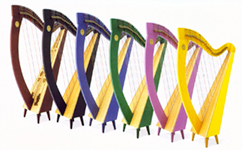The Ancient HarpThe earliest harps were probably small ten-stringed instruments, very different from what is seen today. Much of our knowledge about these instruments stems from pictorial evidence on tomb walls, as early as 4000 BCE. However, the earliest written evidence of such instruments comes from the 12th century. There is evidence that harps played a large role in the religious and secular cultural life of ancient Egypt around 3000 BCE, when the harps were often bow-, spoon-, or spade-shaped, and had from six to twelve strings. Both the instruments and their players held important roles, their music may have accompanied the telling of histories at various functions, or used to accompany religious chants. The harps were held in much the same way as today’s classical harps, though they were much smaller. Later on, one of the most famous harpists was recorded in the Bible, —David would play his harp in order to sooth the king’s migraine headaches. He was perhaps the first music therapist. Stories about Irish, or Celtic, harps also began appearing in literature around the 12th century. Celtic harps were of two forms, according to historians: "one greatly bold and quick, the other soft and pleasing." The first refers to a metal strung harp which was unique to the Irish culture during the medieval period, and the latter to a smaller triangular harp, strung with braided horsehair, and later with gut strings, which would become the ancestor of today‘s concert harps. |
 |
|||
II. The Western European HarpThe greatest difference in form between ancient harps and those used in Western Europe resulted from the addition of a string arm and a pillar (or column) to the soundbox of earlier harp models. The earliest representation of this modification in European harps stands as late as the 14th and 15th centuries, when harpists are often depicted as angelic figures, or as the center of attention in fashionable court-like settings. As musicians continued to adapt to the music of their time, a great deal of experimentation with different types of harp construction and stringing occurred between the 17th and 18th centuries. Through such experimentation, cross-strung harps and triple-strung harps developed, as musicians continued to adapt to the advancing tonal repertoire. |
||||
 |
However, the greatest advancement for the modern harp occurred in the 1720's, by Jacob Hochbrucker in Bavaria. He created a hook-and-pedal mechanism, allowing the harp to produce two pitches per string. The pedals were called "single-action" as they could only change each string by a half step. By moving the pitch-alteration mechanism for changing sharps and flats from the hands-operated levers to the foot-operated pedals, harpists were allowed greater freedom in repertoire, and virtuosic playing soon developed. This development opened an entirely new world of chromatic literature for harpists of the time, and the popularity of the instrument spread to Paris, where it was adored by members of the French court and the fashionable society. It is said that even Marie Antoinette played the harp. It follows that harps from this time were exquisite works of art, ornamented in the rococo style with gilded carvings on the columns and hand –painted flowers on the sounding boards. |
|||
III. The Development of Chromaticism and the Double Action HarpAs with any instrument, modifications in instrument construction follow modifications of musical literature of the period. For instance, as music became increasingly chromatic, the capabilities of the harp followed the shift. During the late part of the 19th century, several experimental harps, such as the Pleyel harp emerged, which was described as a "harpe chromatique sans pédales," or a chromatic harp without pedals. This model resembled the cross-strung style of harp that was famous during the Renaissance in Spain. This Pleyel harp became popular in France and Belgium. One of the most notable compositions for this style of harp was Debussy's Danse sacrée et danse profane of 1904. |
||||
|
||||
IV. Modern Advances for the Harp |
||||
 |
Beginning in the 1980’s the harp showed signs of following a new age of technology. The electric harp is one of the newest advances—for it allows the harp sound to be electronically synthesized and distorted, in much the same way as an electric guitar or piano. With a pick-up microphone on each string, and a processor, the variety of sounds that can be produced is nearly endless. Many have theorized about what the new age will bring to music. Now that our era is more suited to the development of diversity, through the use of electronic distortion and recording systems, the lines surrounding the definition of music itself are clouded. We have now entered into the race of breaking the few conventions that seem to remain as a hindrance to our creativity. J. Haefner
|
|||
Works Consulted:Govea, Wenonah Milton. Nineteenth- and Twentieth-Century Harpists. Connecticut : Greenwood Press, 1995. Palkovic, Mark. Harp Music in the Nineteenth Century. Bloomington and Indianapolis: Indiana Press, 1992. >Rensch, Roslyn. Harps and Harpists. Bloomington: Indiana University Press, 1989. |
||||

